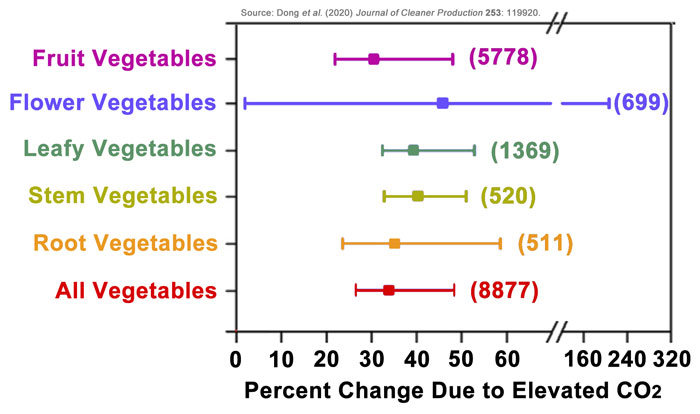| Tweet | Follow @co2science |
Paper Reviewed
Dong, J., Gruda, N., Li, X., Tang, Y., Zhang, P. and Duan, Z. 2020. Sustainable vegetable production under changing climate: The impact of elevated CO2 on yield of vegetables and the interactions with environments-A review. Journal of Cleaner Production 253: 119920.
Noting that "a comprehensive literature review is urgently required to shed light on the effects of elevated CO2 on yield and yield components of vegetables," Dong et al. (2020) set out to complete just such a task.
Using the Web of Knowledge, ScienceDirect and Google Scholar databases, the six scientists conducted a comprehensive literature search for articles examining the impacts of CO2 on vegetables. The resultant search identified 107 references between the years 1964 and 2018. The average ambient CO2 concentration employed in those studies was 350 ppm (range between 200 and 500 ppm) whereas the enriched CO2 concentration averaged 827 ppm (range between 346 and 1200 ppm). The results with respect to vegetable yield are provided in Figure 1 below, revealing a grand mean response for all vegetables and as categorical means of five vegetable types (fruit, flower, leafy, stem and root).
Not surprisingly, the increase in vegetable yield was positive. The grand mean for all vegetable types was a CO2-induced increase of 34% based on 8877 observations. Means of fruit, flower, leafy, stem and root vegetable types were of similar magnitude, increasing by 30%, 40%, 38%, 46% and 35%, respectively. Dong et al. also report that elevated CO2 increased the harvest index by 23% and the root/shoot biomass ratio by 8%. Dry matter was also positively impacted, but the increase was not statistically significant. The increase in vegetable yield, according to the researchers, was mainly associated with a CO2-induced increase in vegetable organ number (32%) and mass (11%), although fruit mass increases (10%) played a role as well.
Dong et al. also evaluated the response of the vegetables to elevated CO2 under aboveground (ozone, temperature and light) or belowground (water, salinity, nitrogen availability and form) growth-limiting conditions. In this regard they report that "increments in vegetable yield tended to be greater [under environmental stresses] compared to the lack of environmental stresses," adding that "elevated CO2 counteracts some of the constraints in yield increases from elevated ozone and heat stress," whereas it did not improve yield under drought stress (compared to well-watered conditions).
The above positive findings reveal a truth that we have been reporting on for over two decades here at CO2 Science, that rising CO2 stimulates crop productivities and yields, which stimulation will greatly assist in global food security efforts as the world's population rises in the years and decades ahead.

Figure 1. Effect of elevated CO2 on yield of different vegetable types (fruit, flower, leafy, stem and root) and all types combined (All Vegetables). Data are means of percent change (relative to ambient CO2 conditions) with 95% confidence intervals (indicated with error bars). The total number of observations in each vegetable category are in parentheses. Adapted from Dong et al. (2020).




